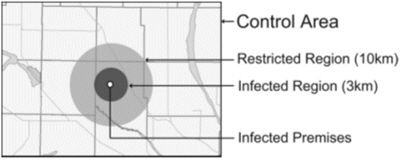



Overview Of CFIA Response To Avian Flu
CANADA - The following summarizes the key measures the Canadian Food Inspection Agency (CFIA) takes in response to a suspect finding of avian influenza in commercial poultry that is subsequently confirmed to be highly pathogenic.
Because each outbreak situation is unique, CFIA responses are flexible and may differ based on a variety of factors. For more detailed information, consult the CFIA Avian Influenza Hazard Specific Plan.
Restrictions on the movement of birds, poultry, poultry products and by-products, and equipment or other things that may have come in contact with birds are put in place around the infected premises:
Cleaning and disinfection
Suspicion of Disease
Preliminary finding of H5 or H7 avian influenza- Avian influenza is a reportable disease in Canada and suspected cases, whether observed on farm, in transport or at slaughter, must be reported to the CFIA.
- When AI is suspected, an assessment of on-farm clinical signs is conducted by a CFIA veterinary inspector, the producer, farm veterinarian and possibly a provincial animal health representative.
- Samples from suspect birds are submitted to the provincial AI network laboratory for preliminary testing.
- Samples of concern, specifically preliminary findings of H5 and H7, are forwarded to CFIA’s national avian influenza reference laboratory in Winnipeg for confirmatory testing. Testing to confirm the ‘H’ type and pathogenicity usually takes 2 to 5 days depending on the quantityof virus present in the samples.
- The decision to quarantine a suspect farm is based on an assessment of preliminary test results and clinical signs observed in birds on-farm.
- In quarantine, all movement of birds, bird products and bird by-products on and off farm is stopped, except under license following an assessment by the CFIA.
- All movement of people and things on and off farm is subject to disinfection measures.
- Depopulation of the flock may begin, before final confirmatory results, based on an assessment of provincial laboratory tests and severity of clinical signs on farm.
- The CFIA will notify the World Organization for Animal Health upon confirmation of a H5 or H7 subtype, or any other subtype which is determined to be highly pathogenic, in domestic poultry.
Disease Response
Depopulation and disposal when highly pathogenic H5 or H7 confirmed
- All flocks on an infected farm are humanely destroyed in a manner that is safe and minimizes potential for spread of the virus.
- Commercial flocks within 1 km of an infected premises and those identified as high risk contacts with the infected premises are destroyed.
- Destroyed birds are disposed of in a manner that minimizes potential for spread of the virus, preferably by onsite composting or burial
Restrictions on the movement of birds, poultry, poultry products and by-products, and equipment or other things that may have come in contact with birds are put in place around the infected premises:
- An Infected Region is established with outer boundary of at least 3 km around any known infected premises. All commercial premises within the region are declared infected.
- A Restricted Region surrounds the Infected Region and has an outer boundary of at least 10 km from any known infected premises.
- A Control Area is established by Ministerial Declaration based on the potential extent of the disease.

- Movement of susceptible poultry and poultry products within the Control Area is strictly controlled through the establishment of a permit system.
- Movement controls are progressively more restrictive moving towards the Infected Region.
- On all infected farms, investigations are conducted to trace the movement of birds, poultry, poultry products and by-products, equipment and people to identify possible sources of infection and possible routes of transmission of virus.
- Enhanced surveillance in commercial and non-commercial poultry flocks is conducted in the 10 km Restricted Region around the infected premises
- Levels of surveillance activity will be developed according to risk of infection in each region in accordance with guidelines of the World Organization for Animal Health.
- Surveillance will be conducted for at least 21 days after the finding of the last infected premises.
Cleaning and disinfection
- Cleaning and disinfection is conducted by the producer to standards set by CFIA.
- Compliance with procedures is enforced and documented through a series of inspections by CFIA personnel.
- Restocking of a previously infected premises may begin 21 days after cleaning and disinfection, depending on the results of surveillance on and around that premises.
Recovery
Release of Control-Area Restrictions
- Surveillance must be conducted in the Restricted Region for at least 21 days after the last infected premises has been cleaned and disinfected.
- Following that period, the Control Area could be rescinded, provided surveillance produces no positive results for AI.
- Canada will provide information to the World Organization for Animal Health to support its claim that Canada is free of highly pathogenic avian influenza.
- AI freedom status could be regained in as little as three months following cleaning and disinfection activities, providing that adequate surveillance has been carried out during that period to demonstrate no further evidence of infection.









